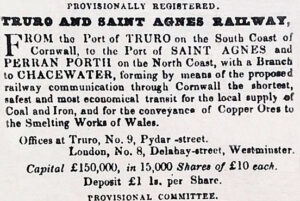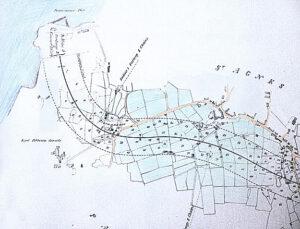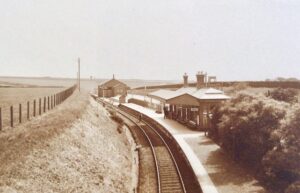
A trainline was proposed through St Agnes to the cliff above the harbour. What was its purpose and route? St Agnes historian, Clive Benney, shares his thoughts on the imaginative project.
Many will have heard of the Chacewater to Newquay Railway that passed through St Agnes Parish between 1903 and 1963 but how many know that there was a proposed railway to St Agnes nearly 60 years before this?
In 1845, fifty thousand tons of Welsh coal, very large amounts of Welsh iron, bricks and tiles from Shropshire and slate from Delabole were annually imported into the port of Truro, and all conveyed there by sea around Land’s End. A railway line between the north and south coasts of Cornwall had been needed for a long time thus avoiding, in the winter months, the perilous voyage of 100 miles.
 This notice appeared in the West Briton of the 31st October 1845 together with the following Prospectus:
This notice appeared in the West Briton of the 31st October 1845 together with the following Prospectus:
The facilities of a transit by railway from St Agnes to Perran Porth(sic) Chacewater and Truro will open an extensive and very populous district abounding in mines, for the consumption of Welsh coal, and will, it is calculated, require annually as many as 80,000 tons to pass over the line…
St Agnes has been, for centuries, the seat of some of the most productive of the tin mines in Cornwall, and their ores are carried by the ordinary roads to the smelting works at Truro. The copper ores also from the mines of Perran and St Agnes are brought to Truro by an expensive land carriage for shipment to the smelting works of Wales. The carriage of these ores will prove a valuable source of traffic to the railway, as will the carriage from Truro of the immence supplies of timber and other materials required in the mines… A considerable passenger traffic at present exists, and will be augmented by a railway communication between Truro, St Agnes and Perranporth, the latter being the favourite watering-place of the inhabitants of Truro and its vicinity.
The length of the proposed line with its branches was about 15 miles. Plans for the new line were drawn by Engineer Richard Thomas assisted by John Thompson. (These detailed plans are now stored at Kresen Kernow, Redruth). The plans show that the line went from Truro to Penstraze where it branched to Perranporth and Chacewater. The West Briton reported: The Perran Porth(sic) line will diverge from the St Agnes Line about four miles from Truro and will pass down the Coombe, through the Perran Great St George and other mines, to a terminus at Perran Porth, contiguous to the Budnick tin mines. The Chacewater Branch will diverge from the St Agnes line at about the same point and proceed to join the Chacewater Station of the proposed railway through the district.
The plans show the main line to St Agnes continued to the left of the main road from Penstraze through Chiverton and today’s Teagle’s Straight. At Sevenmilestone, to maintain level ground, it diverted right towards Goonbell for about a hundred yards before turning left back to Pennwinick Road. From here it kept to the left of the road cutting through Goonvrea Road and to the left of Vicarage Road and Churchtown. It then crossed Trevaunance Road at the far end past the Rocky Lane junction before finishing on the cliff above the harbour. Here there would have been a turntable or similar to turn the train for the return journey.
 Original plan reproduced by permission of Kresen Kernow.
Original plan reproduced by permission of Kresen Kernow.
The above plans show the proposed route, marked in a solid black line, with a dotted line on either side showing the permitted deviation. It is interesting to see that at this time, 1845, one side of Vicarage Road was fields. The building that is now the Railway Inn is shown together with the adjoining house, also two buildings opposite Pengarth Road. From there to Churchtown just fields. Houses on the other side of the Vicarage Road had a clear view to the Beacon hence one today named ‘Beacon View’. What would the residents of these houses have thought if a railway line had come through?
In the end the line was never built. I have not been able to find the reason. Perhaps cost, maybe wishful thinking by those involved or could it have been opposition from the residents of St Agnes who didn’t want their village to look like a Wild West town.
A railway did eventually arrive nearly 60 years later. This time the line had a completely different route. From Truro, passengers travelled on the main line to Chacewater Station where they changed trains for the branch line to St Agnes, Perranporth and Newquay. St Agnes residents however, were not happy with the location of this station because of its distance from the village. Valleys and contours of the land meant that it was built a mile outside. Many St Agnes residents preferred to use Goonbell Halt which was closer.
 St Agnes Station c1910
St Agnes Station c1910
 Clive Benney is a prolific researcher of Cornish history and an avid collector of St Agnes Parish postcards. He is the Vice-Chairman of St Agnes Museum Trust, the Recorder for St Agnes Old Cornwall Society, a Cornish Bard and the author of many books and articles.
Clive Benney is a prolific researcher of Cornish history and an avid collector of St Agnes Parish postcards. He is the Vice-Chairman of St Agnes Museum Trust, the Recorder for St Agnes Old Cornwall Society, a Cornish Bard and the author of many books and articles.

Very interesting thank you. This scheme seems a sensible one for the time to ferry ‘freight’ across Cornwall by land rather than by sea.
It seems there were a few proposals for additional railway lines in Cornwall. There was a proposal in 1864 to put a line along the Idless Valley.
Then in 1893 a proposal by the North Cornwall or the London and South Western Railway Company was being prepared in some detail to go to Parliament at once, to ‘extend their line to Truro via Wadebridge and Newquay. The line will enter Truro from Idless valley and near Trehaverne and a tunnel will be made going under Pydar Street and giving a station at low level at Ferris Town. Thence the line will be carried to Chapel Hill by a viaduct and a junction will be formed with the Falmouth and Penzance lines to the westward of Truro’.